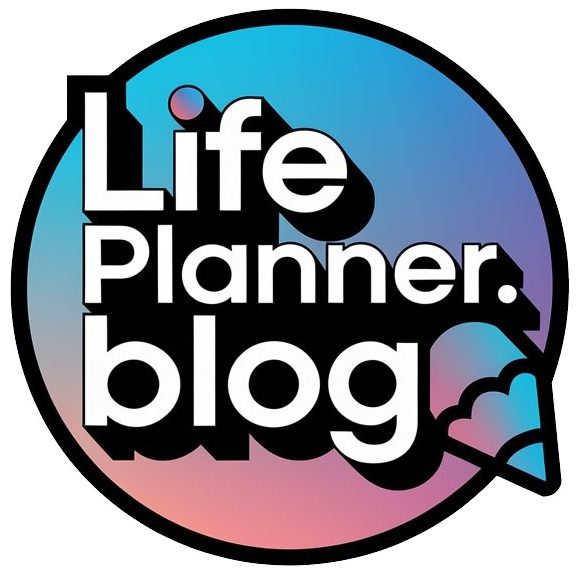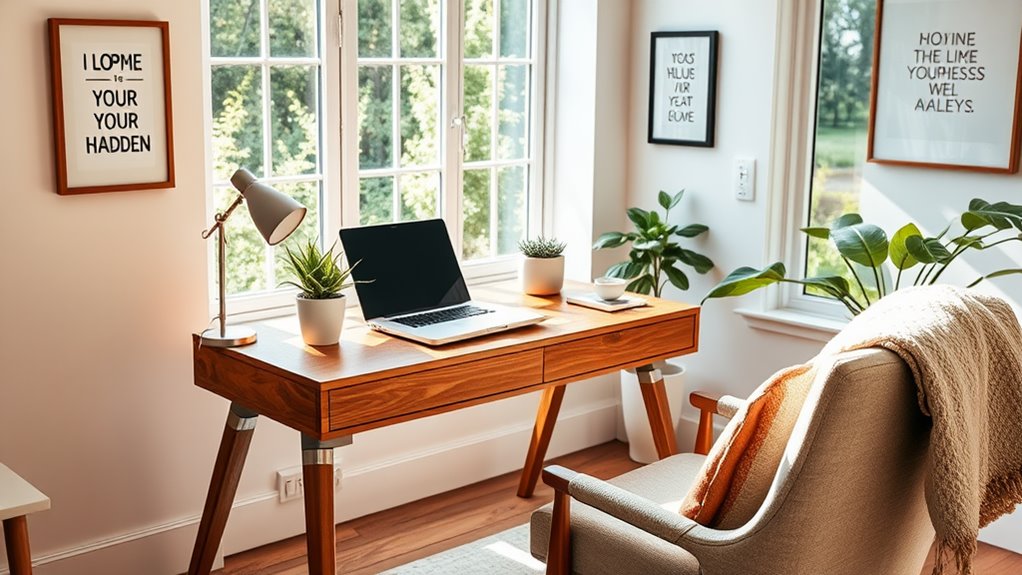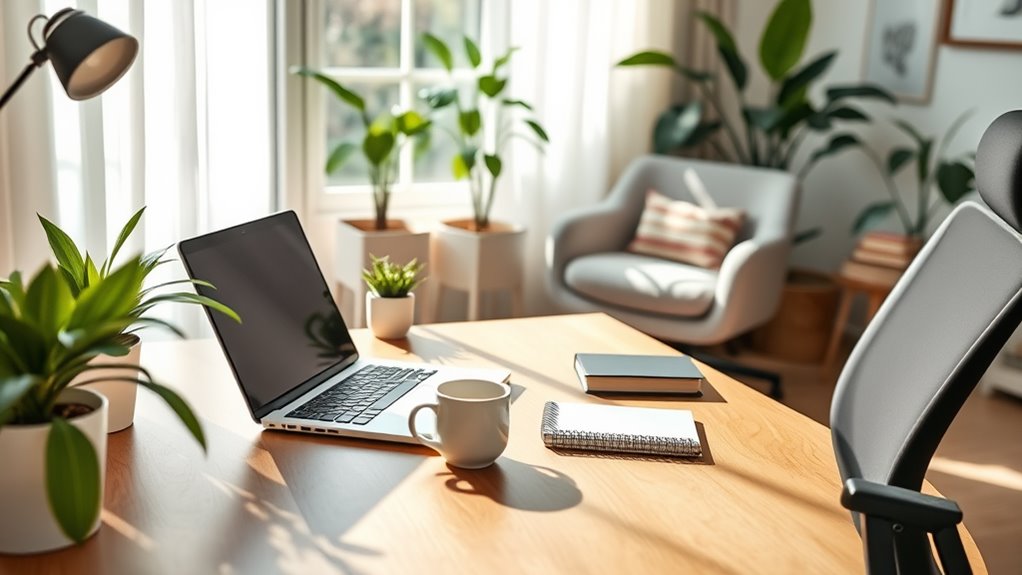Work-from-Home Tips That Maximize Efficiency and Comfort!
To maximize efficiency and comfort while working from home, start by designing an ergonomic workspace that promotes good posture. Establish a structured routine with designated break times to rejuvenate your mind. Minimize distractions by identifying what interrupts you and setting boundaries with household members. Utilize technology for communication and project management to keep tasks organized. Incorporate personal touches in your workspace and position your desk to benefit from natural light. Regularly connecting with colleagues helps foster a supportive atmosphere. These strategies can transform your work-from-home experience—stick around for more tips to elevate your productivity!
Key Takeaways
- Invest in ergonomic furniture to promote good posture and comfort while working to enhance overall productivity.
- Establish a structured daily schedule with scheduled breaks to maintain focus and prevent burnout throughout the workday.
- Minimize distractions by creating a dedicated workspace and setting boundaries with household members during work hours.
- Utilize collaboration tools and project management software to enhance communication and team cohesion in a remote environment.
- Incorporate personal touches and maintain a balance between work and personal space to create an inviting and motivating atmosphere.
Design Your Workspace
Creating an effective workspace is vital for staying productive while working from home. Your environment greatly impacts your focus and efficiency, so it’s essential to design it thoughtfully.
Start with ergonomic furniture; a good desk and chair can make all the difference in your comfort and posture. Invest in a chair that supports your lower back and a desk that allows your elbows to rest at a 90-degree angle.
Next, prioritize workspace organization. Keep important tools and documents within easy reach to minimize distractions. Use storage solutions like shelves or filing cabinets to declutter your desk. Consider a cable management system to keep cords tidy and out of sight.
Natural light can also enhance your workspace; position your desk near a window to boost your mood and energy levels. Incorporate plants or personal touches to make the space inviting, but avoid overcrowding your area with unnecessary items.
Lastly, make sure your workspace is separate from your living areas, if possible. This distinction helps you mentally switch between work and relaxation modes, contributing to sustained productivity.
Establish a Routine
Once your workspace is set up, establishing a routine becomes key to maintaining productivity. A well-structured routine helps you stay focused and energized throughout the day. Try incorporating morning rituals that set a positive tone for your work. This could be a quick workout, meditation, or even a cup of coffee while reviewing your goals.
Time blocking is another effective strategy. By allocating specific time slots for tasks, you create a roadmap for your day, minimizing decision fatigue. Here’s a simple table to help you visualize your routine:
| Time | Activity | Notes |
|---|---|---|
| 7:00 – 8:00 | Morning Rituals | Exercise, breakfast |
| 8:00 – 10:00 | Deep Work Session | Focus on priority tasks |
| 10:00 – 10:15 | Break | Stretch or walk |
| 10:15 – 12:00 | Collaborative Tasks | Meetings, emails |
Minimize Distractions
Minimizing distractions is crucial for maintaining focus while working from home. To achieve this, start by identifying your primary distractions. Whether it’s social media, household chores, or background noise, recognizing these elements is the first step toward effective noise control.
Implement focus techniques like the Pomodoro Technique, where you work in concentrated bursts followed by short breaks. This method not only enhances productivity but also helps you manage distractions more effectively.
Additionally, creating a dedicated workspace can greatly reduce interruptions. Choose a location away from high-traffic areas in your home, and make it your designated work zone.
Consider using noise-canceling headphones or calming background music to block out distractions. Sound can profoundly impact your ability to concentrate, so controlling it’s crucial.
If you share your space, communicate your work hours to others, establishing boundaries that respect your focus time.
Finally, turn off non-essential notifications on your devices. This simple act can greatly reduce the temptation to check your phone or computer, allowing you to maintain your momentum.
Prioritize Comfort
Comfort plays an essential role in maintaining productivity while working from home. When your workspace feels comfortable, you’re more likely to focus and work efficiently. One way to achieve this is by investing in ergonomic furniture. Chairs that support your posture and desks that suit your height can make a significant difference in your daily comfort levels.
Additionally, incorporating personal touches into your workspace can enhance your atmosphere. Surround yourself with items that inspire you, like artwork or plants, to create a motivating environment.
Here’s a quick reference table to help you prioritize comfort:
| Comfort Element | Tips for Improvement |
|---|---|
| Ergonomic Furniture | Choose adjustable chairs and desks for proper posture. |
| Lighting | Use natural light or adjustable lamps to reduce eye strain. |
| Temperature | Maintain a comfortable room temperature with fans or heaters. |
| Sound | Use noise-canceling headphones or soft background music. |
| Personal Touches | Add photos, artwork, or plants for a personalized feel. |
Utilize Technology
To make your work-from-home experience smoother, it’s vital to use the right technology.
Invest in essential work tools that enhance productivity and explore effective communication apps to stay connected with your team.
Essential Work Tools
Utilizing essential work tools can greatly enhance your productivity while working from home. Start by investing in ergonomic equipment, like an adjustable chair and desk, to maintain comfort during long hours. Proper posture not only prevents discomfort but also keeps your mind focused.
Next, leverage productivity software to streamline your tasks. Tools like task managers, time trackers, and project management apps can help you stay organized and prioritize effectively. Set specific goals within these platforms to measure your progress and keep distractions at bay.
Don’t overlook the importance of a reliable internet connection and up-to-date hardware. A fast Wi-Fi connection guarantees smooth communication and access to resources, while a good computer or laptop supports the software you use.
Lastly, consider using cloud storage solutions to keep your files accessible and secure. This allows you to collaborate seamlessly with colleagues, guaranteeing everyone has the latest documents at their fingertips.
Effective Communication Apps
Effective communication is essential when working from home, and the right apps can make all the difference. To enhance your workflow and maintain strong connections with your team, consider utilizing a mix of video conferencing and team collaboration tools.
For video conferencing, platforms like Zoom and Microsoft Teams are invaluable. They offer high-quality video and audio, making virtual meetings feel more personal and effective. You can easily share your screen and collaborate in real-time, ensuring everyone’s on the same page. Utilize features like breakout rooms for smaller group discussions to boost engagement and productivity.
On the team collaboration front, tools like Slack and Trello help streamline communication and project management. Slack allows for quick messaging, while Trello organizes tasks visually, making it easy to track progress. These apps foster an environment where team members can communicate seamlessly, share ideas, and provide feedback without unnecessary delays.
Incorporating these effective communication apps into your daily routine not only maximizes productivity but also enhances your overall work-from-home experience. Embrace technology to maintain clarity and connection with your colleagues, and watch your efficiency soar.
Take Regular Breaks
Taking regular breaks is vital when you’re working from home, as it helps maintain your focus and productivity. By stepping away from your tasks, you allow your mind to reset and recharge. Aim for short, mindful moments every hour, which can greatly boost your efficiency.
During these breaks, engage in purposeful break activities. This could include stretching, taking a brief walk, or practicing deep breathing exercises. Such activities not only relieve physical tension but also enhance mental clarity. Instead of mindlessly scrolling through your phone, consider using this time to disconnect from screens and reconnect with your surroundings.
To maximize the benefits, schedule your breaks in advance. Set a timer to remind yourself to pause and reflect on your progress. This structured approach guarantees you’re less likely to skip breaks out of busyness. Remember, the goal is to refresh your cognitive resources, not just to fill time.
Incorporating regular breaks into your work routine isn’t just beneficial; it’s vital for sustaining high performance levels. You’ll find that these intentional pauses ultimately lead to a more balanced and productive work-from-home experience.
Stay Connected With Colleagues
While regular breaks help recharge your mind, staying connected with colleagues plays a key role in maintaining your motivation and engagement. In a remote work environment, it’s crucial to foster relationships that can enhance your productivity and provide support.
Consider scheduling regular virtual coffee sessions with your team. These informal gatherings let you catch up, share ideas, and create a sense of camaraderie that’s often missing when working from home.
Make use of collaboration tools, like Slack or Microsoft Teams, to maintain an open line of communication. Don’t just stick to work-related chats; engage in light conversations to strengthen bonds.
Take time to celebrate milestones, whether it’s a project completion or a colleague’s birthday. Recognizing achievements fosters a positive atmosphere and boosts morale.
Additionally, participate in team bonding activities, such as online games or challenges. These experiences can break the monotony of work and encourage collaboration.
By prioritizing connections with your colleagues, you’ll not only improve your own work experience but also contribute to a more cohesive team dynamic.
Frequently Asked Questions
What Are the Best Ergonomic Chairs for Home Offices?
When choosing the best ergonomic chairs, consider chair materials like mesh or leather, and look for adjustable features such as seat height and lumbar support. These factors enhance comfort and promote better posture during long hours.
How Can I Improve My Focus While Working From Home?
While distractions pull you away, mindfulness techniques can ground you. Try distraction management strategies like setting specific times for breaks and using meditation to sharpen your focus. You’ll find clarity in chaos, boosting your productivity.
What Are Effective Time Management Techniques for Remote Work?
To manage your time effectively, try the Pomodoro Technique for focused bursts of work, followed by breaks. Also, prioritize tasks daily to guarantee you’re tackling the most important items first, enhancing productivity and reducing overwhelm.
How Do I Avoid Feelings of Isolation When Working Remotely?
Imagine a garden; to thrive, you need sunlight and companions. To avoid isolation, embrace virtual socializing, join online communities, and engage in group activities. It cultivates connection and nurtures a sense of belonging in your workspace.
What Should I Include in My Home Office Setup Checklist?
When creating your home office setup checklist, prioritize office essentials like a quality desk and ergonomic chair. Don’t forget workspace organization tools, such as shelves and storage solutions, to keep your environment clutter-free and efficient.




